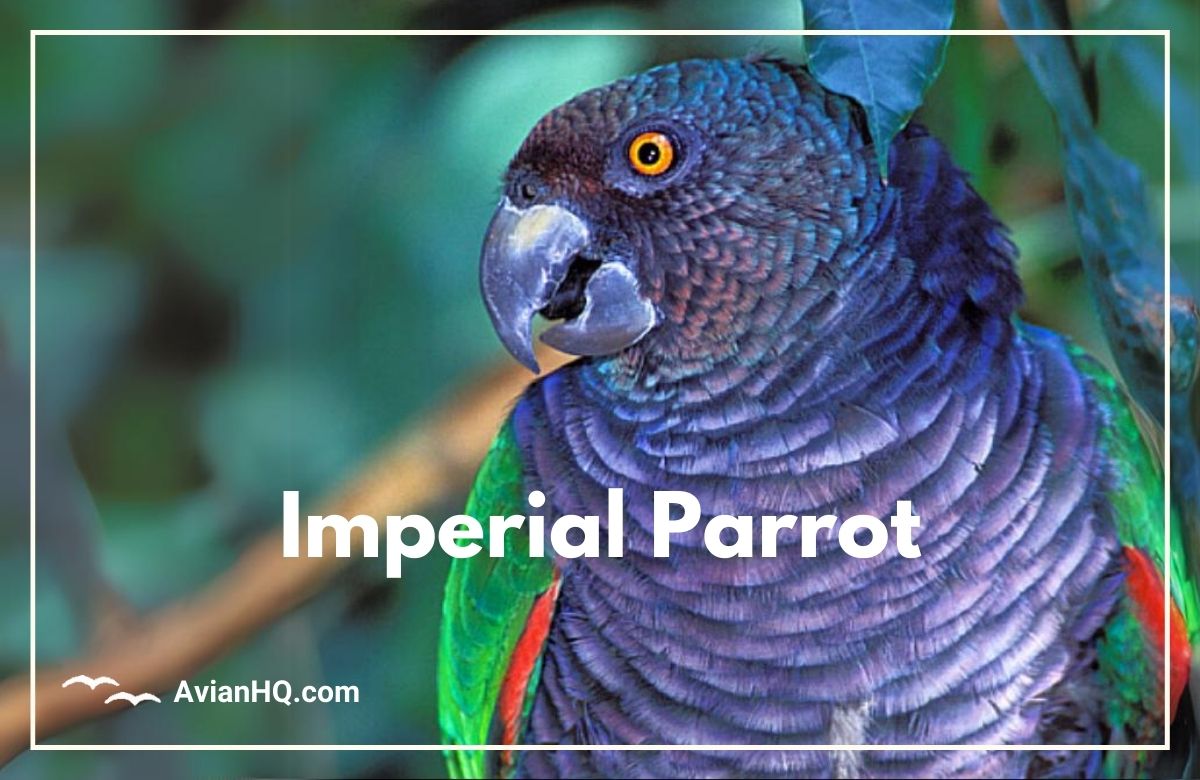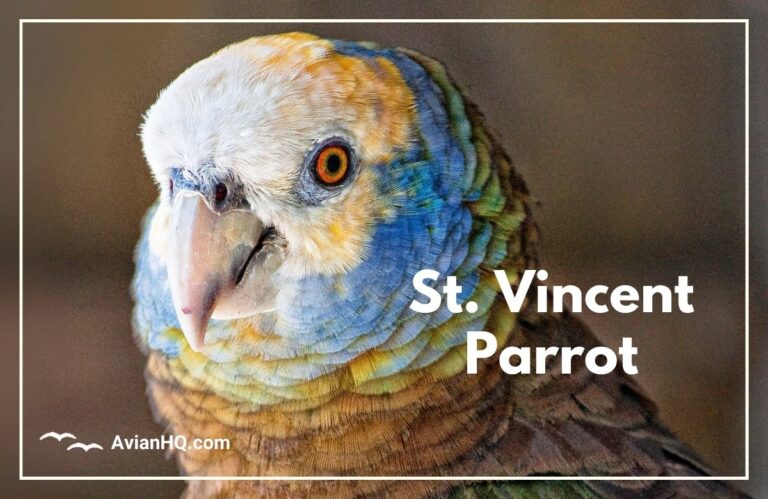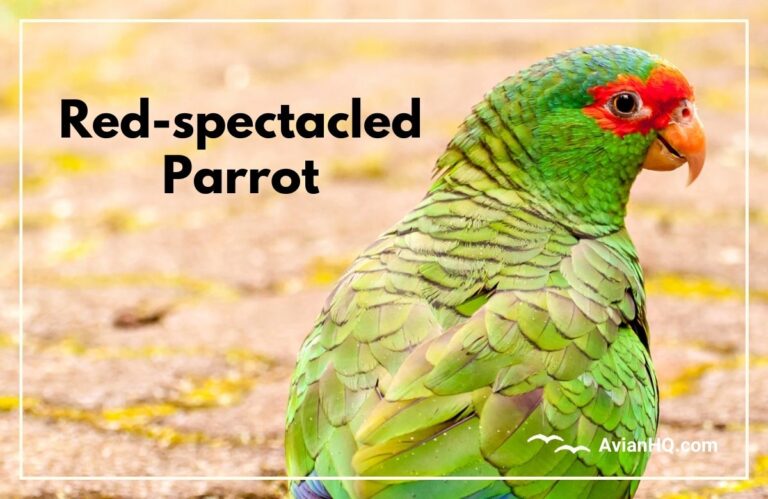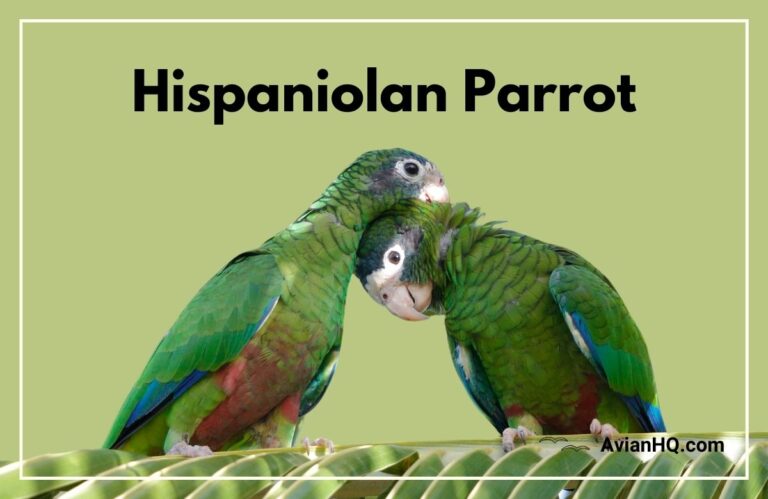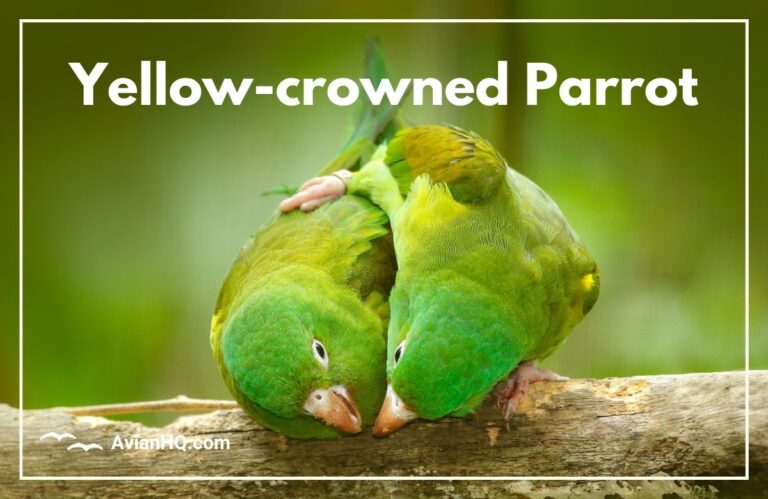Imperial Parrot (Amazona imperialis)
The striking Imperial Parrot, also known as the Sisserou, is a rare tropical bird found only on the Caribbean island nation of Dominica. Reaching up to 19 inches (48 cm) long, this vibrantly colored parrot stands out with it’s deep purple chest, green wings and back, bright red patches under it’s wings, and a white beak.
As you hike along the rugged mountains and rainforests of Dominica, listening to the chorus of bird calls echoing through the canopy, you may catch a glimpse of the Imperial Parrot soaring above the trees. But more likely, these elusive birds will remain hidden in the dense foliage. Their global population is critically low, with likely fewer than 50 mature adults remaining in the wild.
“These birds are so uniquely adapted to Dominica’s mountain forests that they aren’t found naturally anywhere else on Earth,” says Dr. Samantha James, an ornithologist studying Dominica’s parrots. “Losing them would be devastating.”
Centuries ago, the Imperial Parrot could be found island-wide, from the steamy coastal mangroves to the misty peaks over 4,500 feet (1,400 m) high. But due to habitat loss, hunting, and natural disasters, their range has shrunk to only the tallest, most remote rainforests. Without expanded conservation efforts, these iconic parrots may vanish completely.
History and Taxonomy
The Imperial Parrot has a relatively short documented history. Scientists first classified it in 1856 when French ornithologist Charles Lucien Bonaparte gave it the scientific name Amazona imperialis. He likely chose “imperialis” to reflect Dominica’s status as a British colony at the time.
“The species epithet imperialis refers to the national symbol status of this parrot,” explains Dr. Elizabeth Johnson, an expert in Caribbean birds. “Its regal purple and green colors may have also factored into the name choice.”
No recognized subspecies of the Imperial Parrot exist. Some experts speculate that the hypothetical Guadeloupe Parrot (Amazona violacea), also purple-chested, may be the same species or a close relative. But with no living specimens to study, it’s taxonomy remains unresolved.
The Imperial Parrot’s genus, Amazona, contains 30-35 species of mainly Central and South American parrots. Many share physical and behavioral traits with the Imperial Parrot. But it’s total isolation on Dominica has led the Sisserou to evolve into a uniquely insular form.
Physical Appearance
The Imperial Parrot is a large, striking member of the parrot family, though females tend to be a bit smaller than males.
- Length: 16-19 inches (40-48 cm)
- Weight:
- Males – 31-32 ounces (900 grams)
- Females – 22-23 ounces (650 grams)
The bird’s head and chest are a deep purple-maroon, with a slight scaled pattern on the neck. It’s back, wings, tail, and abdomen are olive green, with each feather tipped in black, creating a neat scalloped appearance. Bright red patches are visible under the wings when in flight. The Sisserou’s stout white beak contrasts with it’s colorful plumage. It’s eyes range from orange to red, encircled by grey-brown eye rings.
Both adult and juvenile Imperial Parrots share this vibrant palette. Young birds look essentially identical, with slightly more green patches on the head and duller shades of red and purple.
No notable differences exist between any age or gender classes. This species exhibits no major seasonal variations either. Their appearance stays consistent year-round.
“Sisserous of all ages and both sexes look so similar that even experts studying them struggle to distinguish males from females in the wild,” says Dr. James. “Their plumage is truly identical.”
Habitat and Distribution
The Imperial Parrot is endemic to the island of Dominica in the Lesser Antilles chain of the Caribbean. No introduced populations exist outside of Dominica. This makes the Sisserou uniquely restricted in global range compared even to many other endangered Caribbean parrots.
Within Dominica, Imperial Parrots inhabit higher elevation tropical forests, from around 2,000 feet (600 meters) up to over 4,000 feet (1,300 meters) in elevation. Most sightings occur between 2,000-4,500 feet (600-1,400 meters).
Their favored terrain is steep, rugged mountains and valleys, with a lush rainforest canopy that captures moisture from passing clouds and trade winds. Tall trees like gommier (Dacryodes excelsa) and bois de masse (Sloanea berteriana) that form nesting cavities are vital habitat components.
In some cases, Imperial Parrots may venture down to 500 feet (150 meters) elevation when searching for food. But the highest mountain peaks and remote interior forests make up their primary stronghold, where only the hardiest birds can thrive.
Diet and Feeding
The Imperial Parrot is an omnivorous and opportunistic forager that utilizes many of Dominica’s native rainforest food sources. Their diverse diet includes:
- Fruits – dacryodes, licania, richeria, and other trees
- Seeds and nuts – especially palm nuts
- Flowers and nectar
- Palm shoots
- Some small insects and larvae
They feed mostly in the early morning and evening, spending the brightest hours of the day resting. Imperial Parrots forage high in the tall tree canopy on fruits and nuts. Or they may drop down closer to the ground to nibble on flowers and palm shoots.
While solitary pairs may be seen feeding, more often small foraging flocks of 3-4 Imperial Parrots work together to locate scarce food items across their mountain habitat. They sometimes intermingle with flocks of Red-necked Parrots while feeding.
“Though normally shy birds, Imperial Parrots will quarrel among themselves with squawks and squeals when competing for limited fruit trees in their territory,” notes Dr. James. Their diverse diet and social foraging give them an advantage when resources are poor.
Breeding and Reproduction
The Imperial Parrot is a monogamous species that mates for life. Pairs begin their breeding rituals in February as the dry season arrives. They choose tall, mature rainforest trees with natural cavities for their nest sites, returning to the same trees year after year.
Favored nesting trees include:
- Gommier (Dacryodes excelsa)
- Bois de masse (Sloanea berteriana)
Between February and April, the female lays a clutch of 2 eggs within her chosen cavity. She then incubates them for 26-28 days while the male helps feed her.
Hatchlings are altricial, born featherless and requiring extensive parental care. After about 12 weeks, the young fledge the nest as fully feathered juveniles. However the parents continue supplementing them with food for some time.
Slow to mature, Imperial Parrots don’t begin breeding until about age 5. And pairs on average successfully fledge just a single chick every 2 years due to their small clutch size. This extremely low reproductive rate makes rebuilding their population very difficult after losses to hurricanes, hunting, or habitat destruction.
Behavior and Ecology
The Imperial Parrot is described as calm and docile compared to other Amazona parrots, but remains extremely shy around humans. They are wary birds that flee rapidly and quietly through the forest when disturbed.
Their social structure centers around long-term monogamous pairs bonded for life. Pairs remain solitary for much of the year as they defend their home territory of around a square kilometer of forest.
While feeding, Imperial Parrots may gather in small flocks of 3-4 birds. And they occasionally intermix with groups of 5-10 Red-necked Parrots, Dominica’s other endemic Amazona, likely for added safety.
This species spends most of it’s time perched quietly high in the rainforest canopy, camouflaged by it’s green plumage. Here pairs preen each other and rest between foraging flights.
Imperial Parrots roost in groups of varying sizes in tall trees, depending on food abundance. During breeding season, they retire nightly to tree cavities. And family groups often use the same roosting trees for generations.
Despite their bulk, Imperial Parrots are strong, agile fliers capable of traversing Dominica’s steep mountainous terrain with ease. Their unique adaptations suit the cloud-wrapped elfin woodlands they inhabit better than any other species in the world.
Conservation Status
The Imperial Parrot ranks among the world’s most threatened birds. The International Union for Conservation of Nature (IUCN) Red List categorizes it’s status as Critically Endangered.
Latest surveys suggest there are fewer than 50 mature individuals remaining in Dominica’s wild rainforests. The total global population likely numbers below 100 birds. Without expanded protections, experts believe this species could be extinct in our lifetimes.
Major factors in the Sisserou’s decline include:
- Habitat degradation from logging
- Hunting for food and the pet trade
- Nest predation and competition
- Extended damage from hurricanes
For example, after Hurricane David devastated Dominica in 1979, Imperial Parrot numbers dropped from around 250 to as low as 50 in the 1990s before slowly rebounding. Then Hurricane Maria struck the island in 2017, destroying much of their remaining habitat. The full impacts on an already struggling species have likely not yet been measured.
Dominica’s government now legally protects Imperial Parrots under the Wildlife Protection Act and via national park lands. But threats continue from illegal logging and poaching in remote mountain forests.Expanded environmental education and ecotourism focused on saving Dominica’s endemic parrots offer a hopeful path forward, but time may be running short for the Sisserou.
Cultural Significance
The Imperial Parrot holds a cherished place in Dominica’s cultural identity and history. This prestigious island endemic graces the nation’s flag and coat of arms as a symbol of uniqueness.
Dominicans have long admired the Sisserou’s beauty and valued it as a food source from coastal woodlands to remote mountain villages. Historical petroglyphs also depict Amazona parrots as important components of indigenous culture on Dominica.
But pressures from an expanding human population increasingly threatened the docile bird’s survival. So in 1961, Dominica officially declared the Imperial Parrot as their national bird to be protected and revered as part of their natural heritage.
Today most Dominicans rightfully take great pride in having such an endangered species found only in their country. Some even consider harming or capturing one to be an act of treason against their nation.
Ecotourists now flock to Dominica for a chance to glimpse the exotic Sisserou in it’s cloud forest realm. And birdwatchers rank it among their most sought after prize sightings in all the Caribbean.
“Saving the Imperial Parrot has become a patriotic duty that transcends politics or ethnicity here,” says Dr. James. “It belongs to all Dominica as a living national treasure.”
Conclusion
The Imperial Parrot, Dominica’s vivid purple and green national bird, has entranced people for centuries. But without expanded conservation action, the Sisserou now verges on extinction as it’s population hovers around just 50 mature adults.
Centuries of habitat loss, over-hunting, trade, and devastating hurricanes have relegated the Imperial Parrot to small, remote patches of elfin rainforest high in Dominica’s rugged mountains. These shy but striking parrots have evolved over eons into a unique species found nowhere else on Earth. If they vanish in our lifetimes, we lose a one-of-a-kind glimpse back into evolution.
Protecting expanded tracts of old-growth rainforest, implementing stronger legal protections, containing the pet trade, and boosting environmental education offer hope for the Imperial Parrot’s future. Ecotourism focused on this endangered national bird could also help fund habitat management and local community support.
But the fate of the Imperial Parrot now hangs in a delicate balance. Will Dominicans and the global conservation community choose to ensure this “bird of kings” graces Dominica’s highland canopy for centuries to come? The next decade maydecide whether the Sisserou soars or fades away forever.

